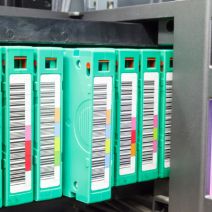Have any question?
Call (409) 861-4450
Call (409) 861-4450
The question this article will present is simple: Does your business have a dedicated data backup and disaster recovery system? A comprehensive backup and disaster recovery platform (BDR) can turn out to be one of the most critical parts of managing a business’ IT infrastructure, and if you don’t have one, you should absolutely get one.
Situations happen all the time to businesses that can really put a lot of stress on their ability to sustain operations. These situations don’t often remediate themselves. Simply put, every business needs a business continuity plan; and one-in-five don’t have one. This month, we thought we would break down a successful plan into its components to try to give businesses that may not have a plan, the basics needed to establish one.
If you have been running a business for any length of time, you definitely don’t need to be told how important risk management is. One problem you see from business owners today is that while they understand just how many problems there are--and which ones they need to find solutions for first--they want to grow their company fast, and as a result, they overlook potential problems and end up hurting their business as a result.
With data looked on as more of an asset than ever organizations are finding that their data backup and recovery system needs to be comprehensive. By knowing more about backup and recovery, you stand to be able to plan the solution to meet your company’s needs. Today, we will look at the different types of data backup and introduce you to four terms you need to understand.
It’s critical that you protect your business’ important assets, including perhaps the most important of all: its data. One of the best ways to do this is by implementing a solid backup solution. But what’s the best way to approach data backup? After all, every business is going to have different needs. We’re here to tell you all about these different needs, and how your organization can implement a reliable backup solution based on yours.
A recent surge of hurricanes, wildfires, earthquakes, and floods have crippled major cities and devastated entire regions all over the world. In the aftermath of these events, business owners are faced with a few glaring truths - one of which is the undeniable vulnerability of their business’ future in the event of a disaster. Most of the major news outlets are reporting this figure: according to the Federal Emergency Management Agency (FEMA), 40% of small businesses never recover from a disaster. Despite all the literature and precautionary tales surrounding these catastrophic events, there are still an overwhelming amount of businesses that choose not to prepare for a disaster until it's too late.
By now, you’ve probably heard about the importance of business continuity and disaster recovery planning for small businesses. According to FEMA, more businesses have business continuity plans than ever before. With so many SMBs looking to secure their future, there are still a few aspects of business continuity planning that today’s business need to comprehend. After all, there is more to it than just data backup. Disaster recovery is something that needs to be planned, practiced and updated.
Few organizations take business continuity planning as serious as financial organizations do. The Federal Reserve Bank (FRB) and Securities and Exchange Commission (SEC), as well as the organizations they oversee, depend heavily on technology for their daily operations. For these establishments, a severe data loss event or significant downtime has the potential to cripple the economy, depending on the severity. As such, they require all of the institutions that they have jurisdiction over to meet certain business continuity benchmarks.
No business owner wants to experience data loss in any way, shape or form, which is why it’s so crucial that preventive measures are taken. If you don’t have protections in place, you may find yourself out of business due to a data loss disaster. While that’s certainly the worst-case scenario, the other consequences of data loss are downright troublesome in their own right.
What would happen if you were in the middle of typing a report or performing some task, and the office suddenly lost power? Too many would find themselves staring blankly at an equally blank screen as their infrastructure suddenly ceased operations. However, there is a device that can help save you from the worst effects of sudden power loss.
What would you do if your business were suddenly struck by something which threatened its very existence? Do you have a plan to make sure that your business survives well past the expiration date assigned by natural disasters, hardware failure, user error, or hacking attacks? One of the most important parts of running a business is managing risk, and implementing a business continuity plan is a great way to focus on the preservation of your organization.
There’s a dangerous misconception that a lot of business owners have about data backup. Too often, an SMB will have a data backup solution in place and the business owner will feel like they’re fully prepared to handle a data loss disaster--without looking into the data recovery capabilities of their backup solution (or the lack thereof). This kind of oversight can lead to a very costly surprise when a disaster strikes and there’s no easy way to restore the lost data.
Every business has to deal with a certain amount of risk from various factors, from hackers, natural disasters, or user error. As a business owner, it’s your responsibility to ensure that your organization can bounce back from a potentially dangerous situation with minimal casualties. We’re here to help you understand the importance of a risk assessment, and what you need to look out for.
 If something debilitating were to happen to you, could your business carry on? This isn’t a pleasant scenario to think about, but it’s absolutely necessary to have a contingency plan in place for reasons like this. Also known as a business succession plan, if you have a plan in place, then you don’t have to worry about what the future holds, at least, for your business.
If something debilitating were to happen to you, could your business carry on? This isn’t a pleasant scenario to think about, but it’s absolutely necessary to have a contingency plan in place for reasons like this. Also known as a business succession plan, if you have a plan in place, then you don’t have to worry about what the future holds, at least, for your business.
 Today is Disaster Preparedness Day! This means that there’s no time quite like the present for preparing for potential future data emergencies. While the type of disasters vary immensely depending on your business’s geographical location, every business needs a disaster recovery plan implemented as soon as possible.
Today is Disaster Preparedness Day! This means that there’s no time quite like the present for preparing for potential future data emergencies. While the type of disasters vary immensely depending on your business’s geographical location, every business needs a disaster recovery plan implemented as soon as possible.
 There’s no question that data backup is absolutely critical for the success of any modern-day business, but how does your organization go about it? Just like how we rely on quick snapshots to capture moments with our smartphones or digital cameras, most backup solutions take advantage of image-based backup technology. How does this kind of data backup work, and what are the benefits it provides your business with?
There’s no question that data backup is absolutely critical for the success of any modern-day business, but how does your organization go about it? Just like how we rely on quick snapshots to capture moments with our smartphones or digital cameras, most backup solutions take advantage of image-based backup technology. How does this kind of data backup work, and what are the benefits it provides your business with?
 If you don’t already have a backup solution put in place, no time is better than the present to consider what it would cost your business if you were to lose everything in one fell swoop. There are plenty of ways you can back up your data, but the reality of the situation is that if you were to lose your business’s information, you wouldn’t be able to continue operations. It would put the entire future of your company in jeopardy, so you need to be absolutely certain that your backup and disaster recovery solution is fool-proof.
If you don’t already have a backup solution put in place, no time is better than the present to consider what it would cost your business if you were to lose everything in one fell swoop. There are plenty of ways you can back up your data, but the reality of the situation is that if you were to lose your business’s information, you wouldn’t be able to continue operations. It would put the entire future of your company in jeopardy, so you need to be absolutely certain that your backup and disaster recovery solution is fool-proof.
 2015 isn’t the year to go without backups. If there’s anything 2014 showed the world, it’s that businesses can fall victim to data breaches when they least expect it. You want to be prepared in the event of a data breach or data loss, and the easiest way to do that is by taking advantage of an external backup. Unfortunately, even an essential solution like data backup can be forgotten amidst the everyday operations of the average business owner.
2015 isn’t the year to go without backups. If there’s anything 2014 showed the world, it’s that businesses can fall victim to data breaches when they least expect it. You want to be prepared in the event of a data breach or data loss, and the easiest way to do that is by taking advantage of an external backup. Unfortunately, even an essential solution like data backup can be forgotten amidst the everyday operations of the average business owner.
 Every business owner knows how important data backup is to their company's continuity plan, and they realize that a disaster recovery solution can help save them in the event of catastrophe. However, some businesses think they are the same thing, and they are sadly mistaken. While they are similar, a backup is not a disaster recovery solution.
Every business owner knows how important data backup is to their company's continuity plan, and they realize that a disaster recovery solution can help save them in the event of catastrophe. However, some businesses think they are the same thing, and they are sadly mistaken. While they are similar, a backup is not a disaster recovery solution.
Get the Knowledge You Need to Make IT Decisions
Technology is constantly evolving, and keeping up can feel overwhelming. Whether you want to understand cybersecurity threats, explore automation, or learn how regulations like PCI DSS impact your business, we’ve made it easy to access clear, straightforward insights on key IT topics.
Learn more about what NetWorthy Systems can do for your business.
NetWorthy Systems
701 W. Division Ave Suite 100
Orange, Texas 77630